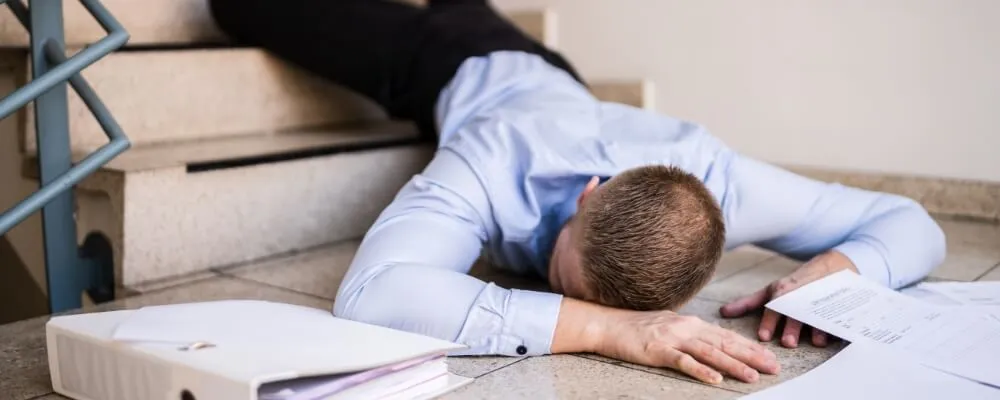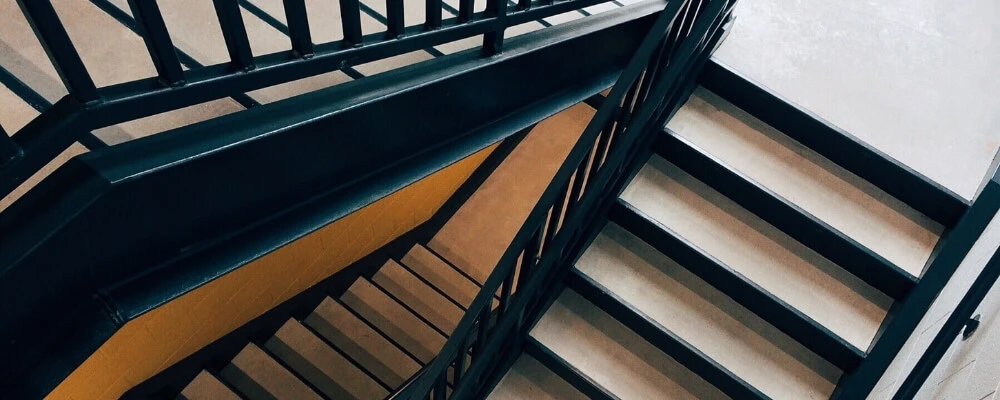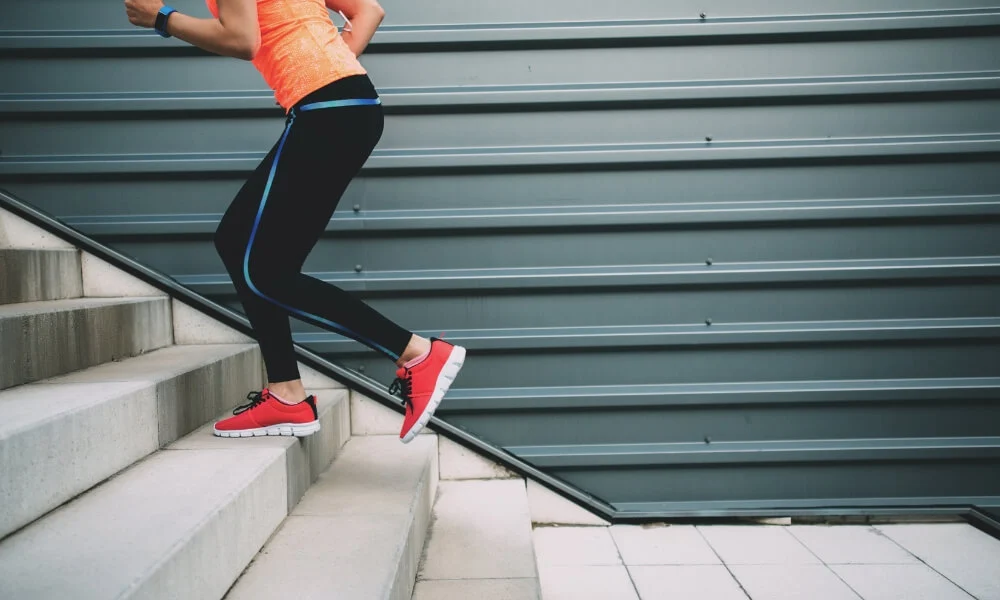Navigating stairs is an everyday activity that many of us don’t give a second thought. However, stairs can pose significant risks if not approached with caution. Every year, countless individuals experience accidents on staircases, leading to injuries that range from minor bruises to serious fractures or worse. Ensuring the safety of these vertical pathways in our homes, offices, and public spaces is crucial.
In this blog, we will delve into 10 essential stair safety tips that can play a pivotal role in preventing slips, trips, and falls. Whether you’re a homeowner, a business proprietor, or someone who uses stairs regularly, this guide offers invaluable insights to help you tread more safely. Join us as we approach a safer environment, one step at a time.
Common Causes Of Stair Accidents
Stair accidents are unfortunately quite common and can lead to serious injuries. Understanding the most common causes can be essential in prevention. Here are the common causes of stair accidents:
- Poor Lighting: Inadequate lighting can make it difficult for people to see each step clearly, leading to missteps, trips, and falls.
- Uneven Step Sizes: As mentioned earlier, step height or depth inconsistencies can cause individuals to trip or stumble because they disrupt the expected rhythm of climbing or descending.
- Slippery Surfaces: Certain materials can become slippery, especially when wet or polished. This includes surfaces like polished wood, tile, or marble. Even carpeted stairs can be slippery if the carpet is worn down.
- Lack of Handrails: Stairs without handrails or poorly positioned or broken handrails don’t provide the necessary support and can lead to falls.
- Obstructions: Items left on stairs, such as toys, shoes, or other objects, can easily cause someone to trip.
- Worn or Damaged Steps: Over time, stairs can become worn out, leading to uneven surfaces. Broken or damaged steps can be unexpected obstacles.
- Inadequate Visual Cues: Stairs without clear visual indicators (like contrasting step edges) can be hazardous for those with vision issues.
- Distracted Walking: Engaging in activities like texting, reading, or even deep conversation can distract individuals and lead to missteps.
- Improper Footwear: Shoes without proper grip or support, such as high heels or flip-flops, can increase the risk of slipping or tripping.
- Rushing or Not Paying Attention: Hurrying up or down stairs or not being mindful of one’s surroundings is a common cause of stair-related accidents.
- Intoxication or Medication: Being under the influence of alcohol, drugs, or certain medications can impair judgment, balance, and coordination, leading to falls.
- Health Conditions: Certain medical conditions, such as balance disorders, vision problems, or leg weakness, can increase the risk of stair accidents.
Understanding these causes can aid in designing, maintaining, and using stairs to minimize accidents and injuries. Safety should always be prioritized, especially in areas like staircases with heightened potential for harm.

Stair Safety Tips to Prevent Slips, Trips, and Falls
Stairs can be a potential hazard if not navigated with care. Here are 10 key stair safety tips to prevent slips, trips, and falls:
1. Proper Lighting
Proper illumination is paramount for stair safety. When a well-lit staircase, each step is visible, reducing the risk of missteps or trips. Having light switches at the top and bottom of the stairs ensures that users can turn on the light regardless of their starting point, negating the need to navigate the staircase in darkness.
Furthermore, motion-activated lighting can be invaluable in cases where someone might be accessing the staircase during nighttime hours—perhaps when they’re groggy or not fully alert. These lights turn on automatically when movement is detected, instantly illuminating the path. Additionally, nightlights can provide a softer glow that can guide individuals without being overly bright, ensuring that the staircase is never plunged into total darkness, even in the dead of night.
2. Handrails
Handrails are not just an accessory for staircases; they are integral to safety. Individuals often rely on handrails for balance and support when ascending or descending a flight of stairs. When a misstep occurs, a strong and reliable handrail can prevent a minor stumble from turning into a serious fall. These handrails must be sturdy and durable, capable of supporting the weight of an adult in case they need to catch themselves.
Furthermore, a handrail that spans the entire length of the staircase ensures that support is available at every point of the journey. The height of the handrail is also a factor; it should be at a level where it’s easily reachable and offers maximum support.
3. Clear Obstructions
Stairs are meant for walking, not storage. Even small objects can pose significant trip hazards when left on a step. Something as seemingly innocent as a child’s toy, a book, or even a stray shoe can become a dangerous obstacle when someone is unaware of its presence on the staircase.
Consistently keeping stairs clear is straightforward, but it can drastically reduce the risk of accidental trips or falls. Regularly checking and clearing the staircase of obstructions ensures the path remains safe for everyone.

4. Non-Slip Surfaces
Staircase materials vary widely—from wood to tile to carpet and more. While some of these materials naturally offer more grip than others, ensuring that every step provides a stable footing is crucial. Non-slip adhesive strips are a practical solution, especially for steps made from smoother materials that may become slippery, particularly when wet.
These strips can be affixed to the edges of each step, providing additional traction where the foot is most likely to land. Additionally, stair treads—covers made from various materials designed to provide grip—can be laid over each step, further increasing the safety of the staircase.
5. Regular Maintenance
Like any other part of a home or building, staircases are subject to wear and tear. Over time, steps can become worn out, or parts of the staircase can break or become loose. Regularly inspecting the staircase allows for the early identification of potential issues.
Addressing these problems promptly—a loose board, a broken step, or another issue—ensures that the staircase remains in top condition. Regular maintenance is not just about aesthetics; it’s a proactive approach to safety, ensuring that every user can trust each step’s integrity.
6. Uniform Step Size
The design and construction of a staircase play a pivotal role in its safety. Each step should be of consistent height and depth across the entire staircase. This uniformity is crucial because our bodies, particularly our legs, and feet, get accustomed to a specific rhythm when ascending or descending stairs. If there’s an unexpected change in step size, it can easily lead to a misstep or trip.
Inconsistencies can be particularly jarring, disrupting the established rhythm, catching us off-guard and potentially leading to accidents. Therefore, particular attention must be paid during construction or remodeling to ensure that every step is consistent with its counterparts.

7. Visual Contrast
Vision plays a major role in safely navigating stairs. For those with vision impairments or the elderly, differentiating between individual steps can sometimes be challenging. Adding a visual contrast, such as painting the edges of steps with a color that stands out from the main step, can significantly enhance visibility. This contrast acts as a guide, clearly indicating where one step ends and the next begins, which can be particularly beneficial in low-light conditions or for those who struggle with depth perception.
8. Sturdy Footwear
The choice of footwear can significantly influence safety on stairs. Shoes that offer a good grip can prevent slips, especially on surfaces that might be smooth or slick. High heels or shoes with worn-out soles can pose a risk, as they might not offer the necessary stability.
Furthermore, avoiding navigating stairs with just socks on is advisable, especially if the staircase is made of wood or tile. Socks can be surprisingly slippery on these surfaces, and without the additional grip that shoes provide, there’s an increased risk of slipping.
9. Avoid Distractions
Stairs require our attention. Engaging in activities like reading, texting on a mobile phone, or carrying large objects obstructing our view can divert our focus from safely navigating the staircase. When distracted, we’re more likely to miss a step or not notice potential hazards, like an object left on the stairs. Giving stairs our full attention is always advisable, ensuring that we’re aware of our surroundings and reducing the likelihood of accidents.

10. Child and Pet Safety
Staircases can be particularly hazardous for young children and pets, who might not have the same level of coordination or awareness as adults. Installing safety gates at both the top and bottom of stairs is a preventive measure to stop them from accessing the stairs without supervision. These barriers act as a physical deterrent, ensuring that even if a child or pet is curious about the stairs, they can’t easily access them.
Alongside these precautions, educating children about the potential dangers of stairs is crucial. By teaching them the importance of not playing on or near staircases and always using handrails, we can instill safe habits from a young age.
Conclusion
In the hustle and bustle of our daily lives, stair safety might not always be at the forefront of our minds. Yet, the repercussions of overlooking it can be dire. Slips, trips, and falls on staircases account for numerous injuries each year, many of which could be easily prevented by adhering to the essential guidelines we’ve discussed. We can dramatically reduce the risk of accidents by ensuring well-lit staircases, uniform step sizes, and clear paths and educating ourselves and our loved ones about the importance of cautious navigation.
Remember, the staircase is not just a physical structure connecting different levels; it’s a space that demands our attention and respect. Let’s prioritize safety in every step, ensuring that each ascent and descent is as secure as possible. After all, with the right precautions in place, we can ensure that every journey, no matter how short, is safe.

